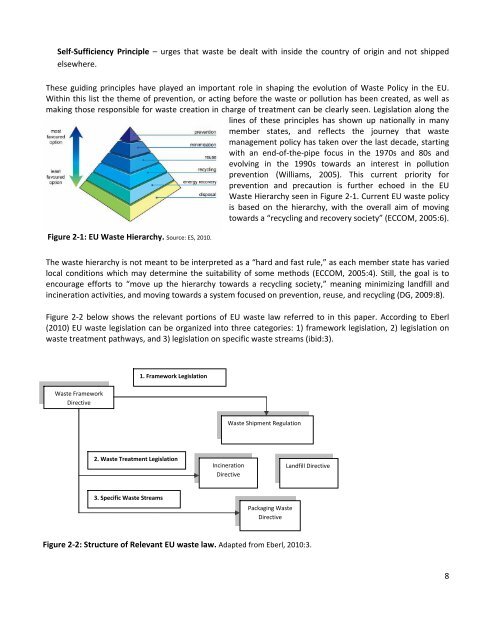Waste prevention and Pay as You Throw, a collective case ... - lumes
Waste prevention and Pay as You Throw, a collective case ... - lumes
Waste prevention and Pay as You Throw, a collective case ... - lumes
You also want an ePaper? Increase the reach of your titles
YUMPU automatically turns print PDFs into web optimized ePapers that Google loves.
Self‐Sufficiency Principle – urges that w<strong>as</strong>te be dealt with inside the country of origin <strong>and</strong> not shipped<br />
elsewhere.<br />
These guiding principles have played an important role in shaping the evolution of <strong>W<strong>as</strong>te</strong> Policy in the EU.<br />
Within this list the theme of <strong>prevention</strong>, or acting before the w<strong>as</strong>te or pollution h<strong>as</strong> been created, <strong>as</strong> well <strong>as</strong><br />
making those responsible for w<strong>as</strong>te creation in charge of treatment can be clearly seen. Legislation along the<br />
lines of these principles h<strong>as</strong> shown up nationally in many<br />
member states, <strong>and</strong> reflects the journey that w<strong>as</strong>te<br />
management policy h<strong>as</strong> taken over the l<strong>as</strong>t decade, starting<br />
with an end‐of‐the‐pipe focus in the 1970s <strong>and</strong> 80s <strong>and</strong><br />
evolving in the 1990s towards an interest in pollution<br />
<strong>prevention</strong> (Williams, 2005). This current priority for<br />
<strong>prevention</strong> <strong>and</strong> precaution is further echoed in the EU<br />
<strong>W<strong>as</strong>te</strong> Hierarchy seen in Figure 2‐1. Current EU w<strong>as</strong>te policy<br />
is b<strong>as</strong>ed on the hierarchy, with the overall aim of moving<br />
towards a “recycling <strong>and</strong> recovery society” (ECCOM, 2005:6).<br />
Figure 2‐1: EU <strong>W<strong>as</strong>te</strong> Hierarchy. Source: ES, 2010.<br />
The w<strong>as</strong>te hierarchy is not meant to be interpreted <strong>as</strong> a “hard <strong>and</strong> f<strong>as</strong>t rule,” <strong>as</strong> each member state h<strong>as</strong> varied<br />
local conditions which may determine the suitability of some methods (ECCOM, 2005:4). Still, the goal is to<br />
encourage efforts to “move up the hierarchy towards a recycling society,” meaning minimizing l<strong>and</strong>fill <strong>and</strong><br />
incineration activities, <strong>and</strong> moving towards a system focused on <strong>prevention</strong>, reuse, <strong>and</strong> recycling (DG, 2009:8).<br />
Figure 2‐2 below shows the relevant portions of EU w<strong>as</strong>te law referred to in this paper. According to Eberl<br />
(2010) EU w<strong>as</strong>te legislation can be organized into three categories: 1) framework legislation, 2) legislation on<br />
w<strong>as</strong>te treatment pathways, <strong>and</strong> 3) legislation on specific w<strong>as</strong>te streams (ibid:3).<br />
<strong>W<strong>as</strong>te</strong> Framework<br />
Directive<br />
1. Framework Legislation<br />
<strong>W<strong>as</strong>te</strong> Shipment Regulation<br />
2. <strong>W<strong>as</strong>te</strong> Treatment Legislation<br />
Incineration<br />
Directive<br />
L<strong>and</strong>fill Directive<br />
3. Specific <strong>W<strong>as</strong>te</strong> Streams<br />
Packaging <strong>W<strong>as</strong>te</strong><br />
Directive<br />
Figure 2‐2: Structure of Relevant EU w<strong>as</strong>te law. Adapted from Eberl, 2010:3.<br />
8
















